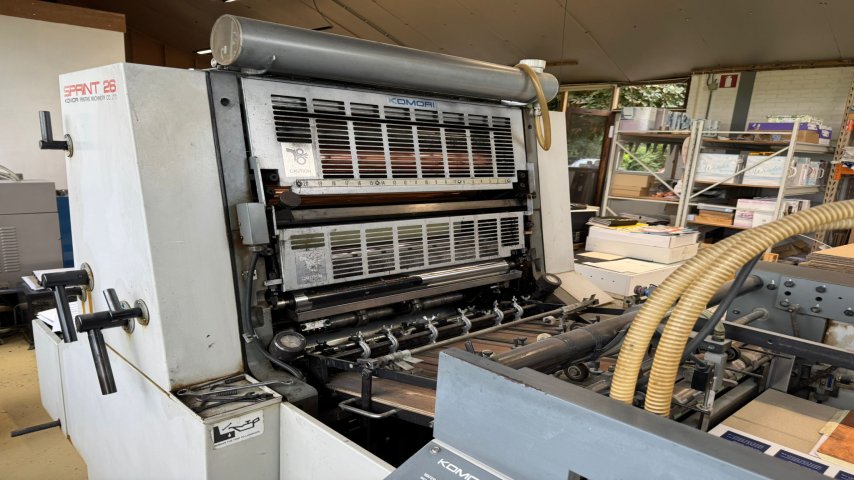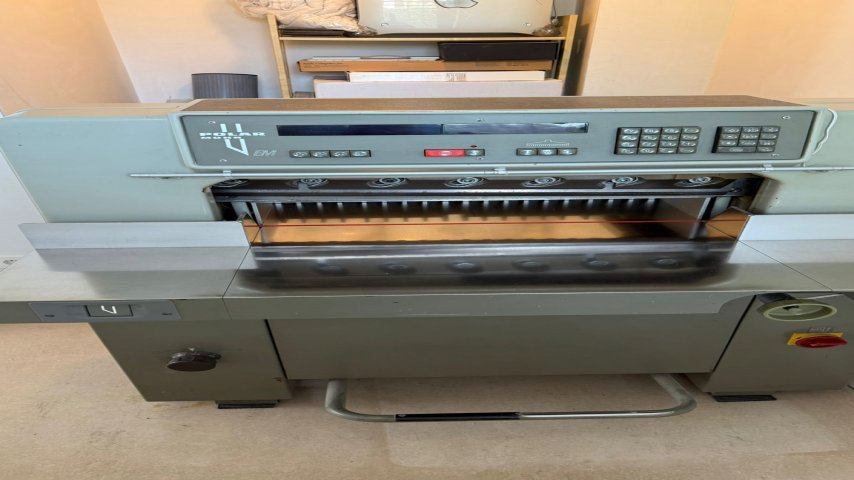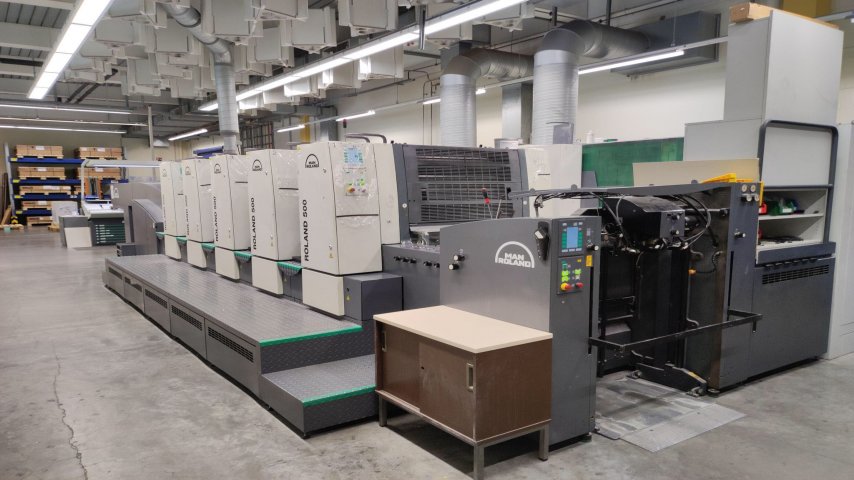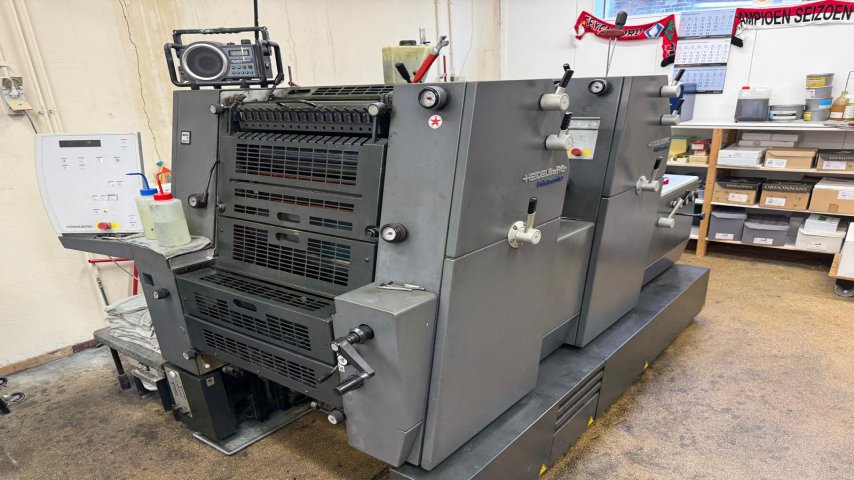- Home
-
Machinery List
Machinery List (148) Stocklist (144) Sheet Offset (23) Converting (109)All Guillotine (16)Folding Machine (18)Perfect Binding (6)Saddle Stitching (4)Gathering (4)Miscellaneous (60)Cross Feeder (1)Web Offset (1) Paper Converting (4) Solid Board Converting (2) Corrugated Board Conv. (2) Preamplifiers (4) Accessory (3)
- Sell machine
- Service
- Contact
Non-stop feeder
Date: 2020-01-30

What Is a Non-Stop Feeder?
A non-stop feeder is an automated system designed to continuously feed paper or other substrates into a printing press without the need for manual intervention or frequent stops to reload material. As the name suggests, the feeder allows for "non-stop" operation, ensuring that there is no interruption in the printing process due to material replenishment.
This system typically works by automatically switching to a fresh stack of paper once the previous stack is depleted, using advanced sensors and mechanisms to detect when the material supply is running low. The seamless transition between paper stacks is crucial for high-volume production runs, as it eliminates the need for operators to pause and reload paper manually. Instead, the machine takes over the process, allowing the print press to continue operating at full capacity.
Key Benefits of a Non-Stop Feeder
1. Reduced Downtime
One of the most significant advantages of a non-stop feeder is its ability to minimize downtime. Traditional printing processes require operators to stop the machine, remove the empty stack of paper, and load a new stack before restarting production. This process can take valuable time, leading to inefficiencies and delays in meeting production targets.
With a non-stop feeder, this process is automated. When the paper supply reaches a certain level, the feeder automatically detects this and switches to the next stack without halting production. As a result, the printing press can run continuously, drastically reducing the downtime typically associated with material reloading.
2. Increased Productivity
The reduction in downtime directly translates into increased productivity. Since the printing press can continue operating without interruption, more work can be completed in less time. This is especially beneficial for large-scale printing operations where high-volume production is a key driver of success.
By ensuring a constant flow of material to the press, the non-stop feeder helps maximize the output of each printing shift, allowing businesses to meet tight deadlines and keep up with high demand.
3. Enhanced Automation and Workflow Efficiency
Non-stop feeders are designed to integrate seamlessly with the printing press's automation system, improving overall workflow efficiency. The automation of material feeding not only speeds up the production process but also reduces the likelihood of human error. Operators no longer need to manually monitor paper levels, manually load stacks, or ensure proper alignment. Instead, the non-stop feeder ensures that the entire feeding process is streamlined and error-free.
With fewer manual tasks to worry about, operators can focus on more important aspects of the production process, such as quality control, maintenance, and troubleshooting. This results in a more efficient and well-managed workflow, allowing the entire operation to function at its best.
4. Improved Material Handling
Material handling can be a complex task, especially in large printing environments where different types of paper or substrates may be used for different jobs. A non-stop feeder can help optimize material handling by ensuring that the paper is fed smoothly and evenly into the press. The feeder is designed to accommodate different paper sizes, weights, and types, which can be adjusted based on the specific needs of the print job.
Additionally, the system is typically equipped with sensors that monitor the quality and condition of the paper. If the paper stack is misaligned, or if there is a potential issue with the material, the system can alert operators to address the issue before it affects the printing process. This capability helps reduce material waste, improves print quality, and ensures the entire operation runs smoothly.
5. Cost Savings
Although the initial investment in a non-stop feeder may seem significant, the long-term cost savings are considerable. The ability to keep the printing press running without frequent interruptions reduces labor costs and increases overall efficiency. With more work completed in less time, printing companies can handle more orders, increasing revenue potential and reducing costs associated with downtime.
In addition to labor savings, the reduction in material waste due to better handling and monitoring helps companies save on raw material costs. With fewer stoppages and less reloading, there is less chance of misfeeds or paper jams, further optimizing material usage and reducing waste.
6. Higher Print Quality
The continuous and consistent feeding of paper helps ensure that the printing press operates smoothly, which directly impacts print quality. When material is fed into the press without interruption, the likelihood of inconsistencies in print alignment, color registration, or ink distribution is minimized.
Furthermore, because the non-stop feeder maintains the correct paper tension and alignment throughout the process, the overall print quality is more uniform and precise. This is particularly important for jobs that require high levels of detail and accuracy, such as high-end marketing materials, packaging, and commercial prints.
7. Flexibility for Long Runs
For printing jobs that involve long production runs, such as large-scale publications or promotional materials, the non-stop feeder is especially beneficial. With its ability to manage continuous paper feeding, it allows for long, uninterrupted print runs, which are critical for meeting tight deadlines or fulfilling large orders.
The flexibility offered by the non-stop feeder also allows for more customization. For instance, printers can adjust settings to accommodate different paper types or run lengths, further enhancing the machine's adaptability to various job requirements.
Conclusion
The introduction of non-stop feeders into printing presses has had a transformative impact on the industry. By reducing downtime, improving workflow efficiency, and increasing overall productivity, non-stop feeders have become an essential component of modern printing operations. These systems help businesses meet the increasing demands for faster turnarounds, higher volumes, and superior quality while also offering cost savings and reduced material waste.
In an industry where every second counts and efficiency is critical, non-stop feeders enable printers to maintain a competitive edge, providing seamless operations and ensuring that they can deliver high-quality products on time, every time. As printing technology continues to evolve, non-stop feeders will remain a vital tool in optimizing production and maximizing performance.
Author: Ahmet Karakus
Tags: Bogenoffset; Digitaldruck; Papierbeutelmaschine; Papierverarbeitung; Rollenoffset; Vollpappe Verarbeitung; Vorstufengeräte; Weiterverarbeitung; Wellpappe Verarbeitung; Zubehör; 1 Farben; 2 Farben; 4 Farben; 5 Farben; 6 Farben; 7 Farben; 8 Farben; 3 Farben; 10 Farben; Verschiedene; Flach&Seitenfaltenbeutel; Klotzbodenbeutel; Kreuzbodenbeutel; Zweinahtbeutel; Druckwerke; Verschiedene; Prägemaschine; Stanztiegel; Stanzzylinder; Querschneider; Rollenschneider; Verschiedene; Zeitungdruck; Akzidenzdruck; Endlosdruck; Etikettendruck; Flexodruck; Tiefdruck; Verschiedene; Etikettenstanzen; Faltschachtelklebe; Autoplatine; Stanztiegel; Fenstereinklebe; Schachtelueberzieh; Verschiedene; CTP-Anlage; Filmbelichter; Plattentwicklungsmaschine; Filmentwickler; Kopiermaschine; Plattenkopierer; Verschiedene; Schneidemachine; Falzmachine; Klebebinder; Sammelhefter; Dreischneider; Zusammentrag; Fadenheft; Buchdeckmaschine; Buchfertigungsstrassen; Verschiedene; Drahtheftmaschinen; Einsteckmaschinen; Kreuzleger; Casemaker; Druckslotter; Hefter & Kleber; Laminiermaschine; Autoplatine; Stanztiegel; Verschiedene; Diverse Geräte; Walzen; Nummerierer werke; Sheet Offset; Digital Print; Paper Bag Making; Paper Converting; Web Offset; Solid Board Converting; Prepress Equipment; Converting; Corrugated Board Conv.; Accessory; 1 Color; 2 Colors; 4 Colors; 5 Colors; 6 Colors; 7 Colors; 8 Colors; 3 Colors; 10 Colors; Miscellaneous; Flat & Satchel; Block Bottom; Cross Bottom; Twin Seam; Print Units; Miscellaneous; Foil Stamping; Handplaten; Punching cylinders; Sheeter; Slitter Rewinder; Miscellaneous; Newspaper; Commercial; Business Form; Label machine; Flexo machine; Gravure; Miscellaneous; Label Punching; Folder Gluer; Autoplaten; Handplaten; Window Patcher; Box Coverer; Miscellaneous; CTP; Film Exposure; Plate developer; Film developer; Copy Box; Plate Copy; Miscellaneous; Guillotine; Folding Machine; Perfect Binding; Saddle Stitching; Three Knife Trimmer; Gathering; Sewing; Block Processing; Book production lines; Miscellaneous; Stitching Machine; Inserting Machines; Cross Feeder; Casemaker; Print Slotter; Gluer & Slitcher; Laminator; Autoplaten; Handplaten; Miscellaneous; Other Device; Roller; Numbering device; Baski Ofset; Dijital Baski; Kagit Torba Makinesi; Kagit Isleme; Rulo Ofset; Kati Karton Isleme; Ön Hazirlik Cihazlari; Ileri Isleme; Dalgali Karton Isleme; Aksesuar; 1 Renk; 2 Renk; 4 Renk; 5 Renk; 6 Renk; 7 Renk; 8 Renk; 3 Renk; 10 Renk; Çesitli; Düz ve Çanta Tipi; Kare Taban Çanta; Çapraz Taban Çanta; Ikili Dikisli Çanta; Baski Ünitesi; Çesitli; Yaldiz Baski; Elle Basma Makinesi; Döner Silindiri; Kesici; Rulo Kesici; Çesitli; Gazete Baskisi; Ticari Baski; Sürekli Form Baski; Etiket Baskisi; Flexo Baski Makinesi; Derinlik Baskisi; Çesitli; Etiket Düzlemesi; Kutu Yapistirma; Otomatik Platen; Elle Basma; Pencere Kapama; Kutu Kapatma; Çesitli; CTP; Film Pozlama; Plaka Gelistirici; Film Gelistirici; Kopya Makinesi; Plaka Kopyalama; Çesitli; Kesme Makinesi; Katlama Makinesi; Mükemmel Ciltleme; Zimbalama; Üçlü Kesici; Toplama; Dikisli Ciltleme; Blok Isleme; Kitap Üretim Hatlari; Çesitli; Dikis Makinesi; Yerlestirme Makinesi; Çapraz Besleyici; Kitap Kapatma Makinesi; Baski Slotteri; Yapitirici & Zimba; Laminatör; Otomatik Platen; Elle Basma; Çesitli; Diser Cihazlar; Rulo; Numaralandirci Cihaz; Impression feuille à feuille; Impression numérique; Machine à fabriquer des sacs en papier; Traitement du papier; Impression offset en bobine; Transformation de carton plein; Équipements de prépresse; Transformation; Transformation de carton ondulé; Accessoire; 1 Couleur; 2 Couleurs; 4 Couleurs; 5 Couleurs; 6 Couleurs; 7 Couleurs; 8 Couleurs; 3 Couleurs; 10 Couleurs; Divers; Type Plat et Sac; Sac de Fond Carré; Sac de Fond Croisé; Sac à Double Couture; Unité d'Impression; Divers; Impression Dorée; Machine de Stamping Manuel; Cylindre Rotatif; Coupeuse; Coupeuse de Rouleaux; Divers; Impression de Journal; Impression Commerciale; Impression de Formulaires Continus; Impression d'Étiquettes; Machine Flexo; Impression en Profondeur; Divers; Mise en Forme des Étiquettes; Collage de Boîtes; Platen Automatique; Estampage Manuel; Fermeture de Fenêtres; Fermeture de Boîtes; Divers; CTP; Exposition de Film; Développeur de Plaques; Développeur de Film; Machine de Copie; Copie de Plaques; Divers; Machine de Coupe; Machine de Pliage; Reliure Parfaite; Agrafeuse; Coupeuse Triple; Rassembleuse; Reliure Cousue; Traitement de Blocs; Lignes de Production de Livres; Divers; Machine à Coudre; Machine de Placement; Alimentation Croisée; Machine de Fermeture de Livres; Slotter d'Impression; Colle & Agrafe; Laminateur; Platen Automatique; Estampage Manuel; Divers; Autres Équipements; Rouleau; Compteur de Nombres; Impresión offset de hojas; Impresión digital; Máquina para hacer bolsas de papel; Procesamiento de papel; Impresión offset de rollo; Procesamiento de cartón sólido; Equipos de preimpresión; Conversión; Procesamiento de cartón corrugado; Accesorio; 1 Color; 2 Colores; 4 Colores; 5 Colores; 6 Colores; 7 Colores; 8 Colores; 3 Colores; 10 Colores; Varios; Tipo Plano y de Bolsa; Bolsa de Fondo Cuadrado; Bolsa de Fondo Cruzado; Bolsa de Doble Costura; Unidad de Impresión; Varios; Estampado en Oro; Máquina de Estampado Manual; Rodillo Rotativo; Cortadora; Cortadora de Rodillo; Varios; Impresión de Periódico; Impresión Comercial; Impresión de Formato Continuo; Impresión de Etiquetas; Máquina de Impresión Flexográfica; Impresión de Profundidad; Varios; Planteamiento de Etiquetas; Pegado de Cajas; Platen Automático; Estampado Manual; Cierre de Ventanas; Cierre de Cajas; Varios; CTP; Exposición de Película; Desarrollador de Placas; Desarrollador de Películas; Máquina de Copias; Copia de Placas; Varios; Máquina Cortadora; Máquina de Plegado; Encuadernación Perfecta; Engrapadora; Cortadora Triple; Recogedor; Encuadernación con Costura; Procesado de Bloques; Líneas de Producción de Libros; Varios; Máquina de Coser; Máquina de Colocación; Alimentador Cruzado; Máquina de Cierre de Libros; Slotter de Impresión; Pegamento & Engrapado; Laminador; Platen Automático; Estampado Manual; Varios; Otros Equipos; Rollo; Contador de Números;Agfa; Agrafix; Baumann; Baumüller; BIMEC SRL; Bindomatic; BITS VOF; Bobst; C.P. Bourg S.A./N.V.; Cito; Cyklos; DAKIOU; DERITEND; Duplo; EBA; Eigenbau (Self-build); Elcos; Eurofold; Eurotechnica; FKS; Foliant; Fuji; Fujifilm; Gallus; GBC; Glunz & Jensen; GUK; Halm; Hang; Heiber + Schröder; Heidelberg; Heidelberg Stahlfolder; Hohner; Horizon; INATEC; Italdibipack; Jagenberg; Josef Foellmer; Kahl; KAS; KBA; KMK; Knorr; Kolbus; Komori; Krause; König & Bauer (KBA); Lintec; MAN Roland; Masterline; Mathias Bäuerle / Baeuerle; Mathias Bäuerle / MB-Bäuerle; Matrix; Max Simmel; MBO; Meccanotecnica; Minolta; Mitsubishi; Mueller Martini; Multigraf; MUTOH; Müller Martini; Nagel; Neolt; Neschen; Nilpeter; OMM; OMMA; Pandway; Perfecta; Pitney Bowers; Plockmatic; Poege; Polar; Polar Mohr; Polyair; Robapac; Robatech; Roland; Ryobi; Sakurai; SCREEN; Screen/FujiFilm; Shinohara; Shoei; Solema; SPS Rehmus; Stahl; Stenz Feeder; Stock; Stube Foerdertechnik GmbH; Thando; Theisen & Bonitz; Viprotech; VITS; Wahli-Stream Feeder; Wohlenberg; 1000 LM laminator; 103 F. AU Pallet turner; 106-MTF autom. foil stamping and die cutting; 107-30; 108 Double head paperdriller; 115; 115 ED; 115 EM-MONITOR; 115 MCS 2 TV; 137 EMC; 14 Tonnen Forklift; 1500-BMY Semi Autom. Die Cutting & Creasing Machin...; 168 HTVC + Basa 7; 185-1; 2 head drilling machine; 201 DFS; 235-121; 280 B; 2L 450EC; 300; 310+; 321; 340 Punch and Closing; 3501 Splitting SAW; 400/4; 4000; 52-2; 522 H; 522 HE; 524 GX; 551; 76 EM; 78 ES; 78 X; Abkantgerät Auto; AC 8000S; ACENTO II S (Screen PlateRite 4300S); Acoro A7; Airspace 9000; APC-T61 hydraulic cutter; Babypack; bizhub press C71hc; BQ 140; BQ 240; BQ 440; Bravo S; BS 25002 PUR; BSW 2/500 L pile turner; BY-800F Autom. Foil Stamping & Creasing Machine; C64-50 autofeed die cutter; CardExtra; CAS 35/2 PBA; CAS 52-4/4; CAS 524 SE; CB 16 stacker; CD 74 (machine parts); CD 74-5-P-C; City 5000; CM-1500A (2R) Roll to Sheet machine; COLDLAM 1400-NE; Compacta C618 48 pages; Conveyor Belt; Creo Magnus 400; cut-tec 76; DB 200; DC 8000 S; DI 425; Diamond 3000 S -5; Digifold creasing and folding machine; Dortmund-Kraft; Double head paperdriller; DUPLO DBMI DSC10/60I line; E3304 cutting machine; EK 420; EM 280; ES 5040 21; Eurobind 600; Exposure-washout-dryer unit Polimero A4; EXS-700 Strapping Machine; F-1050 K Window patcher machine; FA 35/2; Flexo 1600; Folding units for first pocket; FT250 Manual Foam Trim Pro 250; GM 5 Spine taping machine; GMP 450; GT; GTO 46; GTO 46 with N+P; GTO 52-2; GTO 52-2 NP; GTO FPP - 52; GTOV 52; GTOV-S 52; GTOVP 52; GTOZ 52; GTOZP-52; GTOZP-S 52; GYKM-2800 Printer Slotter Inliner; HBJ-D1200 Paper board erecting forming machine; HBJ-D800; HM 6 duble head magazin stitching; Horizon semiautomatic screen printing machines; Iram 16; JET LAM 1600; JP-TWOD-6D; K 52/4 KL - F4; K 820-6 KTLT; KC 56/4 KTL; KD 78/6 KTL; KH 78-4-KTL-RFH-82; KM 600; KSD; L-1000-G-3BF; L375D Laminator; LD 901 Map Folder; Lega 80 - Pressstation; Letterpress museum piece; Lithrone LSX-629 H+F+C+E+D (H-UV-L); LL-600-K-3; LPM 360 Laminating; Mach Eight; Magnus 800 Quantum; Mailmaster 565HS; Mariner 2 perforating machine; Master E; Masterline 410T; MC 8; Merit / 3671; MO Numbering & Perforating Unit; MOZP; MR 500; MULTIGRAF 252 CREASER / PERFORATOR; Multinak S; OD-4012; OHT; P460 Wiro Punching; PB 1006 1 Head drilling; PB 2015 drilling machine; Perfect binder with PUR; Platewriter 2400; Plocmatic 1000 Collating and Stitching Line; PM 52-1 NP; PM 52-2-P; PM 52-4-P; PM GTO 52-2 + with numbering + perforating; prestige FOLDNET 52; PSV 600; PT-R 4100; PT-R 4300; PT-R 4300 E; PT-R 4300 E/ Luxel T 6300 CTP; QRV Variocut; R 506 OB LV; R 705 3B LW; R 705 P 5/0 - 2/3; R 706 3B; RAPIDA 162A 6+lak PWVA ALV3; Roba 40 nozzle glue system; ROBOTAPE 50 M; ROTADIE 15; RSP Easy (Perforating tool); SA 145 APK; SBG; SDD BLM6100 Booklet Maker; SHL 12 P pile lift; SL 12 P; SL 40 Stack Lifter; SL-2-V-E; SM 52 - 5P3; SM 52-2; SM 74 4-P3-H; SM 74 Numbering & Perforating Unit; SM1-600; SORKZ; SORM; SP 1120-E; Stahlfolder TI 52-4-X; Stahlfolder TI 52/6 Proline; Star; Stitching machine; StitchLiner 5500; Suprasetter A52/A74; SX 74-2-P; T 36/4 - F.2; T 530 - 3 - X; T 530-1-53/4 F; T 530-1-53/4F; T 800 4-4-X; T 960-1-960/4; T 960-1-960/4 T 960-2-960/4; T49/4.KB-F.2; TCS 250; TM 530; TMA-20; TP; TrimScor DC545; Twin Screw Extruder LTW 160; UC 1100 Collator; VAC-100a; VALUEJET VJJ-1624; VFZ 52; Vipromat-S semiautomatic screen printing machines; Vitessa Classic Screen Printing with UV Dryer; WJ-1800 Corrugated cardboard making machine; WP 1400 matic window patcher; WP 76; XL 106-4; XL 75-5-P+L C; Z2 Mobile Knife Folding Unit; ZLFM-1080SC Autom. Laminating Machine + powder cle; ZLFM-800SC Autom. Film Laminating Machine + powder; ZLFM-800SJ Autom. Filmlaminiermaschine
Graphische Okkasionen Karakus
Our work consists of the international trade with graphic machines and equipments. Good contacts and over 25 years of experience assure our position on the international market.We distinguish ourselves through serious and uncomplicated handling. Our Monteure are guarantors for satisfied clients.
Imprint
Disclaimer
Blog
Manufacturer information
Specials Machinery
Contact
D-41849 Wassenberg
Tel: +49 - (0) 2432-98 595-0
Fax: +49 - (0) 2432-98 595-29
Email: info@gok-karakus.de







